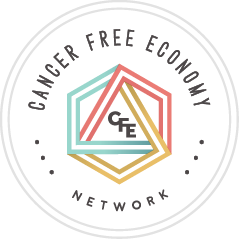Joint Statement on Cancer Prevention
Cancer and Health Leaders Call for Action to Reduce the Burden of Cancer by Addressing Environmental Risk Factors
We all aspire to achieve a cancer-free future. We can fulfill that vision, but only with an ambitious expansion of research, practice, and public policy to prevent the onset of disease.
We now know there are hazardous chemicals in our air, water, food, and the products we use every day. Over the past two decades, science has advanced our understanding of how toxic chemicals in our environment contribute to the development of cancer. Not long ago, tobacco smoke was pervasive, and smoking was encouraged despite scientific evidence of harm. Today, thanks to education, outreach, advocacy, and policy change, fewer people smoke, and thus fewer people get smoking-related cancers. The widespread production and use of harmful synthetic chemicals represents this decade’s untapped opportunity for cancer prevention. Identifying carcinogens and replacing them with safer alternatives can help prevent cancers caused by toxic exposures in our home, our communities, and our workplaces.
Some populations are particularly vulnerable. Research shows that Indigenous, Black, and Latinx people, as well as recent immigrants and people with lower incomes are far more likely to work with toxic chemicals that increase their risk for cancer and are more likely to eat, drink, and breathe more toxic chemicals because of where they live. Children are especially sensitive to environmental chemicals because of their developing bodies. Their young age also means they have more time to develop diseases with long latency periods such as cancer that may be triggered by harmful exposures early in life.
Research to better understand how cancer develops, the role of behavioral and environmental factors, as well as interventions to prevent the initiation of the disease, hold great promise for lifting the burden of cancer over time.
We seek to expand both the definition of what it means to prevent cancer and the ways we can achieve that. We have made great progress in identifying and addressing important lifestyle contributions to cancer (e.g., the importance of diet and exercise, tobacco smoking cessation, limiting alcohol intake). We have made great strides in improving secondary prevention such as early screenings. And, we have made impressive advances in cancer treatments. However, to truly lift the burden of cancer, we must expand the scope and strategies for reducing the high incidence rates of cancer.
That’s why CFE Network’s Health & Science group made it a top priority for 2020 to bring cancer prevention to the forefront for many leading cancer and health organizations with a groundbreaking Joint Statement on Cancer Prevention.
SIGNEES
Alliance of Nurses for Healthy Environments
American Academy of Pediatrics
American Lung Association
American Thoracic Society
American Public Health Association
Bladder Cancer Advocacy Network
Breast Cancer Action
Breast Cancer Prevention Partners
Cancer Free Economy Network
Children’s Environmental Health Network
Joey’s Wings
Latinas Contra Cancer
Lowell Center for Sustainable Production
Max Cure Foundation
National Hispanic Medical Association
National Medical Association
PREP4Gold
Resilient Sisterhood Project
Silent Spring Institute
Stupid Cancer
Swifty Foundation
Young Survival Coalition
Zero Breast Cancer
If your organization wants to support the Joint Statement, we invite you to fill out the form below
GET INVOLVED
Sign up to receive updates, action alerts, and information on how you can support our work or send us a message!

